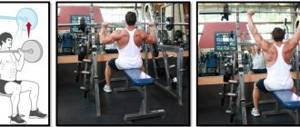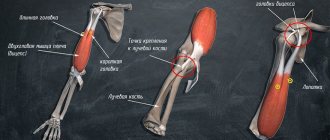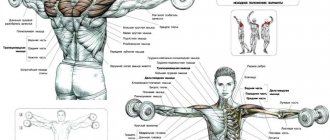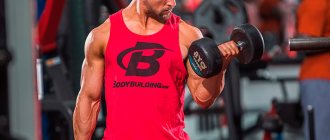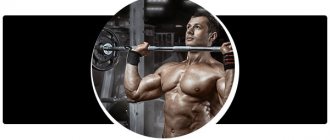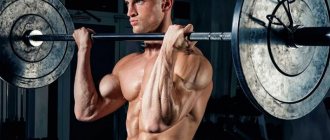Anatomical atlas
Of course, it loads many muscle groups, therefore, it refers to multi-joint training:
- the load is directed mainly to the anterior bundles of the deltoid muscle;
- synergists here: serrated anterior muscles, triceps, lower and middle trapezius, supraspinatus, lateral deltas;
- the dynamic stabilizer is the long head of the triceps;
- the muscles responsible for raising the shoulder blades and the top of the trapezius act as stabilizers.
At the same time, the biceps, large and pectoral muscles work, and the abs are loaded.
The view of the anatomical atlas can be seen in the picture below:
Let's remember the anatomy
It's no secret that the seated barbell press is a multi-joint exercise. Here a whole group of muscle fibers is involved in the work:
- synergists, namely the lateral bundles of the deltoid muscles, triceps, supraspinatus muscle fibers, serratus anterior muscles;
- the anterior parts of the deltoid muscle bundles take on the bulk of the load;
- the role of stabilizers is played by a group of muscles that raises the scapula, as well as the trapezius muscles;
- the role of a dynamic stabilizer is assumed by the head of the triceps muscles.
But that's not all. When lifting a barbell from the chest while sitting, additional muscle groups are involved in the work - the pectoralis major, biceps and even the “cubes” on the stomach.
Correct technique
This exercise, which is difficult in terms of coordination, requires strict adherence to the technique, which is presented step by step below.
Preparatory step: you need a bench, sitting on it across or along (located between your legs), you need to grab the barbell with a grip wider than your shoulders. Place it on your upper chest. Keep your back straight. This is the starting position from which the training is performed.
First step: inhale, then exhale, simultaneously squeezing the projectile upward. It should be directly above your head. Inhale again and return to the starting position to repeat the exercise.
To make it clearer, a picture is given below.
Useful tips
The following tips will help you get the most out of the exercise and avoid injury:
- the grip is chosen such that the angle between the shoulder and forearm is straight at the lowest point of the trajectory;
- you need to direct your gaze forward, for which you choose a point in front of you (on the wall), which you look at during the entire exercise;
- in order to control the trajectory of the barbell, at first it is advisable to perform the exercise in front of a mirror (lateral projection);
- to support the lower back, when moving to medium and heavy weights, it is necessary to use a weightlifting belt;
- For the same purpose, you can use the bar located on the stand of the bench press. The middle of the back is leaned against it;
- the arms are not fully extended at the top point: the elbow joint is slightly bent;
- for those who have problems with the rotator cuff muscle, it is not recommended to perform a barbell bench press while sitting with the apparatus behind the head (do it from the chest);
- keep your back straight throughout the training;
- lifting and lowering the weight is carried out without jerking - smoothly and controlled;
- use the entire range of motion available to the barbell;
- below and above do not rest.
If you follow all the recommendations, you don’t have to think about technique – you’ll do the barbell bench press while sitting, you’ll do it right.
What to choose: barbell or dumbbell press
Exercises with a barbell are attractive because progress in the development of muscles and strength occurs more quickly. This is explained by the fact that training allows you to lift very large weights. But it must also be said about the disadvantages: the stronger hand, taking on the main load, does not allow the development of the other, which lags behind it in development, which leads to the appearance of asymmetry, unbalanced muscle development. For development, the barbell press is very productive if done while sitting.
The dumbbell version is good if correction of the deltoid muscles is required. Therefore, it is advisable to include both exercises alternately in the training process.
You can choose a different tactic: train for a couple of months, doing military presses, and then move on to training with dumbbells.
Seated Barbell Press vs. Standing Bench Press
The lower back is not “friendly” with “sedentary” loads, so people who move little (office workers, etc.) suffer from lower back pain. To unload the back, a barbell press is best suited for them, but from a “standing” position, not a “sitting” one, during which there is less shearing lateral force. In addition, when a person stands, the gluteal and core muscles work, which serve as stabilizers for the spine. A “standing” athlete manages to push out more weight due to the large power force that develops.
Safety is no less important: it is easier for an athlete who makes movements while standing to drop the barbell to the floor. When performing a seated barbell press, this cannot be done without the help of a partner. Therefore, it is recommended to do a standing military chest press. The barbell overhead press is done while sitting on a Scott bench.
Features of the seated press
- Performed slowly, without jerking through the full amplitude. The movement is uniform.
- It is important to breathe correctly. The air in the lungs distributes the load on the vertebrae.
- Required level of training: beginner.
- Difficulty: medium. When working with heavy weights, a belay partner is required.
Tools
- Bench, barbell.
Joints involved: elbow, shoulder, shoulder blades.
Trajectory of movement
- at the top point the bar is pulled out behind the head, the bend in the elbow joints is maintained;
- at the lowest point, the elbow joints are brought forward.
What mistakes can happen when doing a seated press?
- Sudden movements harm the spine and reduce efficiency.
- Leaning forward injures joints. Risk of dislocations and sprains.
- Bending in the lower back injures the lumbar region.
Comparative characteristics of different bench press options
The research was carried out by Norwegian specialists. They compared using AMG (electromyography) the degree of activity of muscle fibers when performing various variations of the press and the position of the apparatus (dumbbell press, barbell press, chest press, behind the head press), and strength.
Here's what happened when testing triceps, three delts and biceps
EMG result characterizing the anterior delta
- comparing seated barbell and dumbbell presses (from the same position), it turns out that muscle activation is 11% higher when performing seated dumbbell presses;
- when comparing standing dumbbell presses and military chest presses, it turned out that muscle activation during the first training session was higher;
- it is 8% greater for the standing dumbbell press when compared with the seated dumbbell press.
The result of EMG – studies of the medial head and middle delta
- when pressing dumbbells while standing, muscle activation is 7% higher than when lifting a barbell in the same standing position;
- if we compare the dumbbell press while sitting and standing, in the second version the muscles are activated 7% more than when the dumbbell press is performed while sitting.
EMG indicators for the posterior delta
- when performing a standing barbell press, activation is 25% higher than when performing the exercise with the same apparatus from a sitting position;
- comparing training with dumbbells from the “sitting” and “standing” positions, the second option is 25% superior to the first.
Biceps study data (EMG)
- Compare: sitting dumbbells and sitting barbell. In the latter case, the difference is 33%, the second option wins.
- Having compared “standing dumbbells” and “standing barbell”, it was found that in the second case the activation value is 16% higher;
- For standing dumbbell presses, muscle activity is 23% greater compared to training from a sitting position with the same sports equipment.
Triceps EMG Research Data
- when doing a standing barbell press, in comparison with the same thing but with dumbbells, the first option wins, for which muscle activation is 39% greater;
- Comparing the barbell while sitting and standing, they found that activation was 20% higher in the second case.
Regarding power tests (1 RM), the results are as follows:
The performance is 7% higher in the standing barbell press than when using standing dumbbells and 10% higher than when using the seated dumbbell press.
In general, research has proven that:
- An athlete needs more mobility and stability when doing a standing press (overhead) than when doing a seated press;
- standing bench press training (with a barbell and/or dumbbells) results in greater neuromuscular activity in the deltoid muscle compared to “seated” training (with a barbell and/or dumbbells);
- The triceps and biceps are more activated when standing training with a barbell is performed than when doing seated presses of any apparatus.
Having become familiar with the nuances of the exercise in detail, it is clear that it has been undeservedly forgotten. Decent training must be included in the training program if you want to achieve results.
Video: Bench press sitting in front of you
What are the options?
This exercise has many options that you need not only to know about, but also to actively apply in practice. However, it is not always clear which method is better. Below we look at comparisons of options in the areas of effectiveness and safety:
- Dumbbells or barbell? The main advantage of using a barbell is the ability to lift more weight, which allows you to quickly gain muscle mass and achieve strength. The downside is that a strong arm will take most of the weight on itself. The result may be muscle asymmetry (which may be unsightly). In 2013, large studies were conducted on this issue. So, scientists were able to prove that working with a barbell from the chest allows you to quickly develop strength and is best suited for working the deltoid muscle fibers. Thus, it is worth including two types of presses in the training process - with a barbell and dumbbells, alternating them with each other. For example, one month you can exercise using a barbell, and the next month using dumbbells.
- Bench press sitting or standing? Few people know, but with a seated military press, the lower back receives a lot more load. For example, the same office workers literally suffer from back problems due to constant sitting in one place. If the body is in a standing position, then the lateral force will be much less. In addition, the buttocks and core muscle groups are included in the work. As a result, you will be able to handle a lot more weight. Don't forget about one more important point - safety. When working while standing and it is impossible to complete a set, the barbell can be dropped. If you perform the exercise while sitting, you will have to attract an assistant. As a result, it is better (and safer) to do the chest press while standing. When winding the bar behind the head, a sitting position is allowed.
- Which presses are best and with which equipment? Norwegian scientists took up this issue at one time. They conducted an experiment and compared different exercise options (different equipment, positions, and so on). They then studied muscle electromyography and force expression. The study was conducted on all heads of the deltoids, triceps and biceps.
The results were as follows:
- For the anterior deltoid:
- when working with dumbbells (compared to using a barbell), the activity of muscle groups is 11% greater;
- The dumbbell press is 15% more effective than standard barbell work from the chest;
- working with dumbbells while standing is 8% more effective than sitting.
- For the middle deltoid:
- the bench press with dumbbells gives a 7% greater effect (compared to using a barbell);
- The standing barbell press is 7% more effective than sitting with dumbbells.
- For the posterior deltoid:
- when doing a standing press, the muscle receives 25% more activation than when working with a barbell;
- Using dumbbells while standing is 24% more effective than sitting.
- For biceps. Here the results are also very interesting. When comparing the effectiveness of exercises using dumbbells and a barbell, the muscles are more active when working while sitting with a barbell. If we compare two exercises with dumbbells or a standing barbell, the second option wins (16% more effective). When it comes to working with dumbbells, a standing workout is 23% more effective than a similar bench press done while sitting.
In addition, it is worth highlighting a few more important points:
- performing overhead presses requires greater stability from the athlete;
- in most exercises performed while standing, the deltoids are loaded more;
- When working while standing, the triceps and biceps work more actively.

